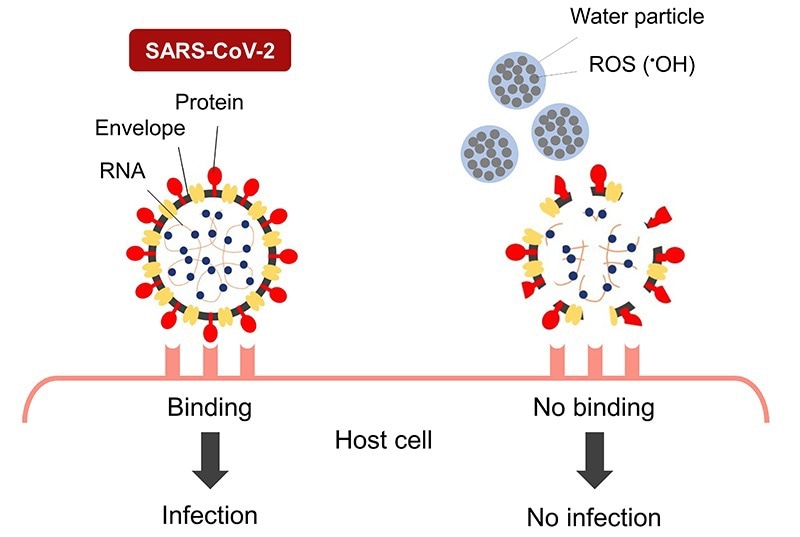SARS-CoV-2 envelope, protein, and RNA can be destroyed by nano-sized electrostatic atomized water particles, which eventually impairs the ability of the virus to attach to host cells.
 When the envelope, protein, and RNA of SARS-CoV-2 are damaged by nano-sized electrostatic atomized water particles, the virus is unable to bind to host cells. Image Credit: Osaka Metropolitan University.
When the envelope, protein, and RNA of SARS-CoV-2 are damaged by nano-sized electrostatic atomized water particles, the virus is unable to bind to host cells. Image Credit: Osaka Metropolitan University.
The World Health Organization does not recommend frequent spraying or fogging of biocidal chemicals, or UV light sterilization, in inhabited spaces since current disinfection procedures have significant limitations.
Nano-sized electrostatic atomized water particles created by a Panasonic Corporation electrospray device are one viable solution. The water particles include reactive oxygen species (ROS), which may damage lipids, proteins, and DNA while also disinfecting bacteria and viruses.
Associate Professor Yasugi’s team previously showed that nano-sized electrostatic atomized water particles cleanse SARS-CoV-2, but the mechanism remained unknown.
The impact they saw when SARS-CoV-2 was exposed to nano-sized electrostatic atomized water particles is described in their latest work, which was published in the Journal of Nanoparticle Research.
While examining the virus’s effects, the researchers discovered that atomized water particles reduced SARS-CoV-2’s infectivity to cells.
“We observed that the nano-sized electrostatic atomized water particles damaged the viral envelope, protein, and RNA, making them unable to bind to host cells. The phenomena we observed are considered the main mechanism by which the nano-sized electrostatic atomized water particles disinfect SARS-CoV-2.”
We found that the target of the water particles is not the specific viral specific structure or specific proteins. Because the water particles impact viral envelope, protein, and RNA, they may disinfect other enveloped viral species as well.
Mayo Yasugi, Associate Professor, Osaka Metropolitan University
Funding
Panasonic Corporation’s Living Appliances and Solutions Company supported this research.
Journal Reference:
Yasugi, M., et al. (2022) Mechanisms underlying inactivation of SARS-CoV-2 by nano-sized electrostatic atomized water particles. Journal of Nanoparticle Research. doi:10.1007/s11051-022-05485-5.